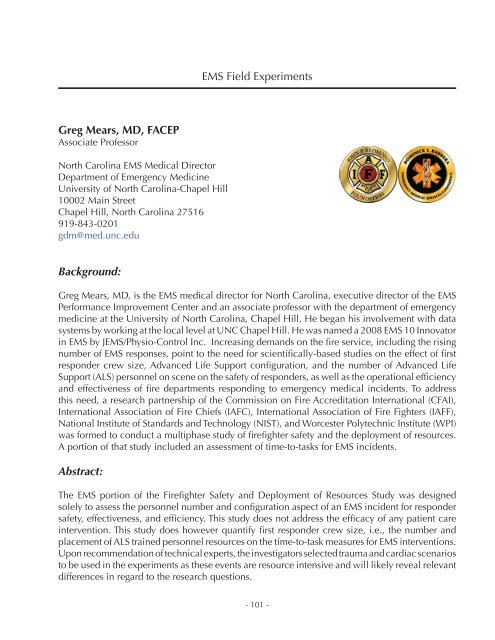Redmond EMS Abstracts.indd - IAFF
Redmond EMS Abstracts.indd - IAFF
Redmond EMS Abstracts.indd - IAFF
Create successful ePaper yourself
Turn your PDF publications into a flip-book with our unique Google optimized e-Paper software.
<strong>EMS</strong> Field Experiments<br />
Greg Mears, MD, FACEP<br />
Associate Professor<br />
North Carolina <strong>EMS</strong> Medical Director<br />
Department of Emergency Medicine<br />
University of North Carolina-Chapel Hill<br />
10002 Main Street<br />
Chapel Hill, North Carolina 27516<br />
919-843-0201<br />
gdm@med.unc.edu<br />
Background:<br />
Greg Mears, MD, is the <strong>EMS</strong> medical director for North Carolina, executive director of the <strong>EMS</strong><br />
Performance Improvement Center and an associate professor with the department of emergency<br />
medicine at the University of North Carolina, Chapel Hill. He began his involvement with data<br />
systems by working at the local level at UNC Chapel Hill. He was named a 2008 <strong>EMS</strong> 10 Innovator<br />
in <strong>EMS</strong> by J<strong>EMS</strong>/Physio-Control Inc. Increasing demands on the fire service, including the rising<br />
number of <strong>EMS</strong> responses, point to the need for scientifically-based studies on the effect of first<br />
responder crew size, Advanced Life Support configuration, and the number of Advanced Life<br />
Support (ALS) personnel on scene on the safety of responders, as well as the operational efficiency<br />
and effectiveness of fire departments responding to emergency medical incidents. To address<br />
this need, a research partnership of the Commission on Fire Accreditation International (CFAI),<br />
International Association of Fire Chiefs (IAFC), International Association of Fire Fighters (<strong>IAFF</strong>),<br />
National Institute of Standards and Technology (NIST), and Worcester Polytechnic Institute (WPI)<br />
was formed to conduct a multiphase study of firefighter safety and the deployment of resources.<br />
A portion of that study included an assessment of time-to-tasks for <strong>EMS</strong> incidents.<br />
Abstract:<br />
The <strong>EMS</strong> portion of the Firefighter Safety and Deployment of Resources Study was designed<br />
solely to assess the personnel number and configuration aspect of an <strong>EMS</strong> incident for responder<br />
safety, effectiveness, and efficiency. This study does not address the efficacy of any patient care<br />
intervention. This study does however quantify first responder crew size, i.e., the number and<br />
placement of ALS trained personnel resources on the time-to-task measures for <strong>EMS</strong> interventions.<br />
Upon recommendation of technical experts, the investigators selected trauma and cardiac scenarios<br />
to be used in the experiments as these events are resource intensive and will likely reveal relevant<br />
differences in regard to the research questions.<br />
- 101 -

















